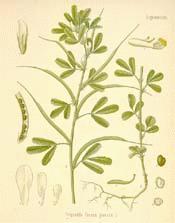
Botanical.com Home Page

|
Fenugreek
(Trigonella foenum-graecum LINN.)
Click on graphic for larger image
|
Fenugreek
Botanical: Foenum-graecum (LINN.)
Family: N.O. Leguminosae
---Synonyms---Bird's Foot. Greek Hay-seed.
---Part Used---Seeds.
---Habitat---Indigenous to the countries on the eastern shores of the Mediterranean. Cultivated in India, Africa, Egypt, Morocco, and occasionally in England.
---Description---The name comes from Foenum-graecum, meaning Greek Hay, the plant being used to scent inferior hay. The name of the genus, Trigonella, is derived from the old Greek name, denoting 'three-angled,' from the form of its corolla. The seeds of Fenugreek have been used medicinally all through the ages and were held in high repute among the Egyptians, Greeks and Romans for medicinal and culinary purposes.
Fenugreek is an erect annual herb, growing about 2 feet high, similar in habit to Lucerne. The seeds are brownish, about 1/8 inch long, oblong, rhomboidal, with a deep furrow dividing them into two unequal lobes. They are contained, ten to twenty together, in long, narrow, sickle-like pods.
Taste, bitter and peculiar, not unlike lovage or celery. Odour, similar.
---Constituents---About 28 per cent mucilage; 5 per cent of a stronger-smelling, bitter fixed oil, which can be extracted by ether; 22 per cent proteids; a volatile oil; two alkaloids, Trigonelline and Choline, and a yellow colouring substance. The chemical composition resembles that of cod-liver oil, as it is rich in phosphates, lecithin and nucleoalbumin, containing also considerable quantities of iron in an organic form, which can be readily absorbed. Reutter has noted the presence of trimethylamine, neurin and betain; like the alkaloids in cod-liver oil, these substances stimulate the appetite by their action on the nervous system, or produce a diuretic or ureo-poietic effect.
[Top]
---Medicinal Action and Uses---In Cairo it is used under the name of Helba. This is an Egyptian preparation, made by soaking the seeds in water till they swell into a thick paste. Said to be equal to quinine in preventing fevers; is comforting to the stomach and has been utilized for diabetes. The seeds are soaked in water, then allowed to sprout, and when grown about 2 or 3 inches high, the green eaten raw with the seeds.
The seeds yield the whole of their odour and taste to alcohol and are employed in the preparation of emollient cataplasms, ointments and plasters.
They give a strong mucilage, which is emollient and a decoction of 1 OZ. seeds to 1 pint water is used internally in inflamed conditions of the stomach and intestines. Externally it is used as a poultice for abscesses, boils, carbuncles, etc. It can be employed as a substitute for cod-liver oil in scrofula, rickets, anaemia, debility following infectious diseases. For neurasthenia, gout and diabetes it can be combined with insulin. It possesses the advantage of being cheap and readily taken by children, if its bitter taste is disguised: 1 or 2 teaspoonful of the powder is taken daily in jam, etc.
The ground seeds are used also to give a maple-flavouring to confectionery and nearly all cattle like the flavour of Fenugreek in their forage. The powder is also employed as a spice in curry. At the present day, the ground seeds are utilized to an enormous extent in the manufactures of condition powders for horses and cattle; Funugreek is the principal ingredient in most of the quack nostrums which find so much favour among grooms and horsekeepers. It has a powerful odour of coumarin and is largely used for flavouring cattle foods and to make damaged hay palatable.
In India the fresh plant is employed as an esculent.
---Other Species---
Trigonella purpurascens, a British species,with small pinky-white flowers, one to three together, and straight, six- to eight-seeded pods, twice as long as the calyx.
[Top]
Common Name Index
A MODERN HERBAL Home Page
Bear in mind "A Modern Herbal" was written with the conventional wisdom of the early 1900's. This should be taken into account as some of the information may now be considered inaccurate, or not in accordance with modern medicine.
© Copyright Protected 1995-2025 Botanical.com
|

